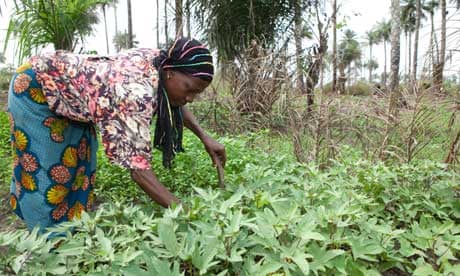In July 2003, African leaders meeting in Maputo, Mozambique, committed to allocating 10% of their national budgets to agriculture by 2008, and to increasing annual agricultural growth to 6% of GDP. Their aim: to eliminate hunger, and reduce poverty and food insecurity. Their instrument of choice: the Comprehensive Africa Agriculture Development Programme (Caadp), a platform that brings together key players – including the government, the private sector and civil society – at national, regional and international levels to improve co-ordination and share knowledge.
Ten years later, just eight countries – Burkina Faso, Ethiopia, Ghana, Guinea, Malawi, Mali, Niger and Senegal – have reached or exceeded the 10% spending target, and nine – Angola, Eritrea, Ethiopia, Burkina Faso, Congo-Brazzaville, Gambia, Guinea-Bissau, Nigeria, Senegal and Tanzania – have achieved agricultural growth of more than 6% per annum.
By any standards, Caadp should be considered a failure. But speak to almost anyone involved in agriculture in Africa – NGOs, farmers, donors and the UN – and they will tell you it has been successful.
"Look at any other sector in Africa and look at what Caadp has been able to do for the past 10 years … I think that Caadp has been a key driver when it comes to refocusing on a priority sector for Africa," says Mouhamed Lamine Ndiaye, pan-African head of economic justice at Oxfam.
"We have here a forum for political dialogue whereby the African constituents bring the African perspective on agricultural issues," says Bernard Rey, deputy head of the EU's rural development, food security and nutrition unit. "As a development process, the [European] commission believes it is exemplary. It has its difficulties but it's interesting."
While meaningful dialogue between the government and farmers has not been possible in many countries, where it has taken place, for example in Kenya, results have been impressive. "Caadp has really contributed quite significantly to bring the public and private sector to sit around the same round table – it has brought that paradigm shift within our operations," explains Peter Mwangi Gitika, general manager in charge of programmes, projects and resource mobilisation for the Kenyan National Farmers Federation. "Farmers are able to talk, and they are listened to."
When the programme was established, spending on agriculture in Africa – both in the public sector and development aid – was declining, says Martin Bwalya, head of Caadp. Spending and growth were stagnant and some countries were regressing. "[Agriculture] needed massive reform. It was not just an issue that you pour money on – that's what we did in the four or five decades before Caadp. So Caadp was also saying, what more do we need to do? It was pointing to very systemic reforms," he adds.
According to Bwalya, over the past 10 years, the continent has begun to tackle some fundamental issues. Ethiopia, he says, has demonstrated clearly the importance of institutional reform in supporting sustained agricultural growth. In Rwanda, quality investments, better planning, accountable systems and the use of ICT have made a real impact.
One criticism levelled against Caadp is that it has done little to help the most marginalised farmers – women smallholders, who on average account for about 55% of the labour force and carry out about 70% of farm work, but represent just 8% of land ownership.
"We realised that, after analysing [agricultural] investment plans, we could not find any specific budget that goes to women," says Fatou Mbaye, Livelihoods Thematic Manager with Acord, whose research has shown that when women have equal access to land and resources they can increase crop yields by 25%-30% and reduce the level of hunger by 12%-17%.
"We need to invest in women farmers in order to increase production, but also to reduce hunger and malnutrition," she says. "We definitely need, at national level, some really strong frameworks that support women farmers – especially in terms of land reform."
Land rights remain one of the most contentious issues facing Africa. "We will not be able to do anything on agriculture if we don't resolve the issue of land," Ndiaye says.
The declaration by the African Union that 2014 will be the year of agriculture and food security has prompted calls for a reassessment of Caadp. It follows the AU's pledge in July to eradicate hunger on the continent by 2025, although no concrete plans on how this would be achieved were forthcoming. Debates about the future of agriculture are expected over the coming months.
What next for the programme?
Adama Coulibaly, head of the UN economic commission for Africa's agricultural production systems sector, believes the quality of investments needs to be improved. "We need to rethink the way that public spending in agriculture is made … If we are putting in just $1, we have to ensure that this generates more than $1," he says.
For some countries – for example, Ethiopia, Ghana and Mauritius – the return on spending on agriculture has exceeded expectations. But for the majority of African countries, the transformative impact of each dollar spent has not produced the right results.
"We need to shoot for overall growth in the range of two digits but to do that agriculture cannot be the only driver. We need to make sure that we have agricultural growth with something else – services and industry," insists Coulibaly. This is why the UN economic commission for Africa has been pushing for commodity-based industrialisation, he says. "That is where most of the value addition and wealth can be created."

Comments (…)
Sign in or create your Guardian account to join the discussion